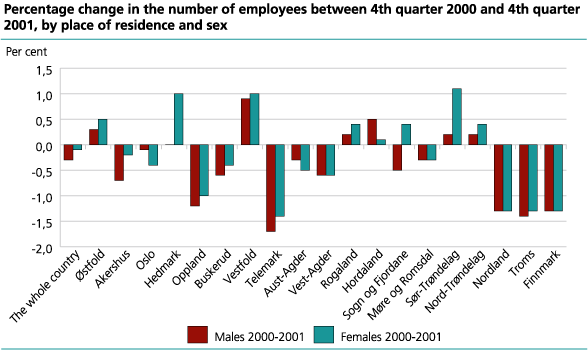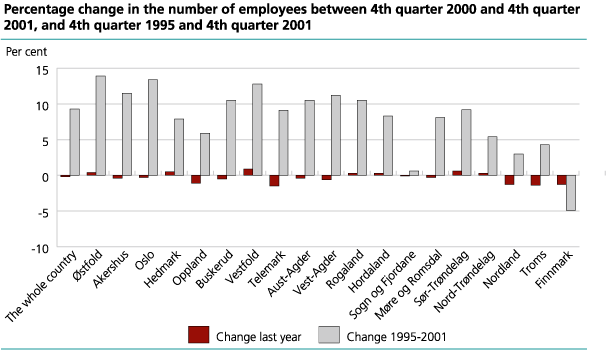Content
Published:
Fewer employees in 12 counties
Telemark had the largest decrease in the number of employees by 1.5 per cent between the 4th quarter 2000 and the 4th quarter 2001. Vestfold had the largest increase by 0.9 per cent. During the same period the number of employees in Norway declined by 0.2 per cent.
Telemark, Troms, Nordland, Finnmark and Oppland had all a decrease of 1.0 per cent or more.
For the entire country the decrease was 0.3 per cent for males and 0.1 per cent for females. Telemark had the largest percentage decrease among both male and female employees, by 1.7 per cent for the males and 1.4 per cent for the females.
The largest increase in the number of male employees was found in Vestfold, with 0.9 per cent. Sør-Trøndelag had the largest increase in the number of female employees, by 1.1 per cent, followed by Hedmark and Vestfold, with an equal increase of 1.0 per cent.
Between 1995 and 2001 the number of employees increased by 9.3 per cent. Østfold had the largest increase with 13.9 per cent, followed by Oslo by 13.4 per cent and Vestfold by 12.8 per cent. Finnmark was the only county with a decrease in the number of employees, 4.9 per cent.
Still an increase in the number of employees above 55 years
Norway experienced a decrease in the number of employees for all age groups, except for those between 55-66 years, an age group that are still growing. All counties had an increase in the number of employees in the age group 55 to 66.
Nord-Trøndelag was the only county with an increase in the number of employees under 25 years of age, and Oslo was the only county with an increase for those between 25 and 39 years. Among employees between 40-54 of age only Rogaland and Sogn og Fjordane experienced an increase, but the number of employees above 55 years of age increased in all counties.
Increase in full-time jobs
In the 4t h quarter 2001 88,8 per cent of the male employees had a full-time job, 30 hours or more in settled working-hours per week. The corresponding figure for the females was 59.4 per cent. Møre og Romsdal had the highest percentage of men working full-time, 90.4 per cent, while Nord-Trøndelag had the lowest percentage with 86.4 per cent. Oslo had the highest percentage of women working full-time with 76.9 per cent. Nord Trøndelag also had the lowest percentage of women working full-time, 46.1 per cent.
The percentage of Norwegian men working full-time is the same in 2001 as in 1995, while there has been an increase in the percentage of women working full-time.
More employees with higher education
27.8 per cent of the employees had a tertiary education in 2001. The highest percentage of employees with a tertiary education was found in Oslo and Akershus, with 41.6 and 31.7 per cent respectively. Østfold had the lowest with 22.1 per cent. The last year all counties had an increase in the percentage of employees with tertiary education.
What other statistics show
Statistics Norway's Labour Force Surveys (LFS) have already released Employment statistics for the entire country, for the 4t h quarter 2001. The LFS show a weak increase in the number of salaried employees between the 4th quarter 2000 and the 4th quarter 2001. However, the difference between the weak increase in the LFS and the slight decrease in the Employee statistic is within the statistical uncertainty, which is due to the fact that LFS is based on sample surveys. The difference in the level of employees (7.6 per cent), which is bigger than the statistical uncertainty, are due to the fact that the LFS cover more brief and occasional jobs. The LFS have also released figures for Norway per the first quarter 2002.
Tables:
- Table 1 Population and Employees 16-74 years, by place of residence. 4th quarter 1995, 2000 and 2001
- Table 2 Employees 16-74 years, by age and county of residence. 4th quarter 1995, 2000 and 2001
- Table 3 Employees 16-74 years, by county of residence and age. In per cent of the population. 4th quarter 1995, 2000 and 2001
- Table 4 Employees 16-74 years, by age and county of residence. Per cent. 4th quarter 1995, 2000 and 2001
- Table 5 Employees 16-74 years, by age and county of residence. Per cent. Male. 4th quarter 1995, 2000 and 2001.
- Table 6 Employees 16-74 years, by age and county of residence. Per cent. Female. 4th quarter 1995, 2000 and 2001
- Table 7 Employees 16-74 years, by settled working hours in the primary employment, sex and county of residence. Per cent. 4th quarter 1995, 2000 and 2001
- Table 8 Employees 16-74 years, by settled working hours in the primary employment, age and county of residence. 4th quarter 2001
- Table 9 Employees 16-74 years, by sex, field of study and level of education. 4th quarter 2000 and 2001
- Table 10 Employees 16-74 years, by level of education, sex and county of residence. Per cent. 4th quarter 2000 and 2001
The statistics is now published as Employment, register-based.
Contact
-
Statistics Norway's Information Centre
E-mail: informasjon@ssb.no
tel.: (+47) 21 09 46 42


